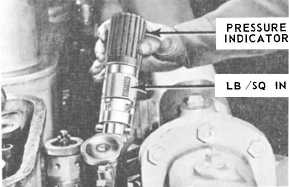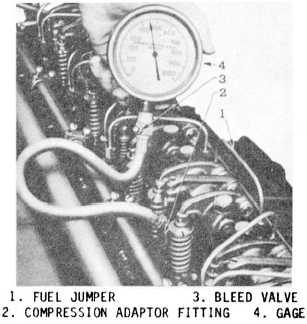Chapter 3—ENGINE MAINTENANCE
cutout mechanism, or a loss of compression. If,
after checking the air cleaner, the filter, and the
fuel cutout mechanism, you determine that the
problem is due to loss of compression, then you
must perform a compression check with a cylinder
pressure indicator.
There are several different types of indicators
that may be used. Most indicators used with
diesel-cylinder engines are either of the spring
balanced type or the trapped pressure type. They
are manufactured by various companies such as
Kiene, Bacharach, and Kent-Moore. Some of
these indicators measure only compression
pressure, others measure both compression and
firing pressures.
Spring Balanced Indicator
A spring balanced indicator, such as the one
manufactured by Bacharach (figure 3-1), employs
a spherical ball piston, which is held on its seat
by the force of a helical spring actuated by the
cylinder pressure which acts against the bottom
of the ball piston to oppose the spring tension.
Before the indicator is attached to the engine, the
vulcanized handle must be rotated clockwise
until the reading on the counter is greater than
the maximum cylinder pressure expected. The
amount of this pressure is listed in the engine
manufacturer’s technical manual. When the
indicator is installed, the operator must make sure
that it is placed as near the cylinder as possible
and position it so that it can be read easily. After
the indicator is installed the engine is operated at
the specified rpm, then the fuel to the cylinder
Courtesy of Bacharach, Inc., USA
75.238X
Figure 3-1.-Spring balanced Pressure Indicator.
being tested is cut out, the cylinder test cock is
opened, and the spring tension on the indicator
is adjusted. The tension of the spring is reduced
b y r o t a t i n g t h e v u l c a n i z e d h a n d l e
counterclockwise until the maximum cylinder
pressure barely offsets the spring pressure. At this
point, the latch mechanism of the indicator trips
and locks the handle firmly in position, giving a
direct and exact reading of the pressure in pounds
per square inch (psi). To reset the lock mechanism
for a new reading, the handle must be rotated
counterclockwise one-fourth turn. When this in-
dicator is stowed for future use, the indicator
spring must be unloaded by rotating the handle
counterclockwise until a zero pressure reading is
obtained.
Trapped Pressure Indicators
In this type of indicator, the cylinder gases
enter past a valve into a chamber which leads to
a gage. When the pressure above the valve equals
that of the cylinder, the valve seats and traps the
gas above the valve at its highest pressure, then
this pressure is read on the gage. There are several
other types of indicators. The one pictured in
figure 3-2 is used to take compression readings
Courtesy of Bacharach, Inc., USA
75.238X
Figure 3-2.—Trapped Pressure Indicator (small boat).
3-3




